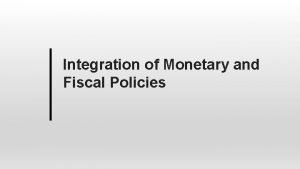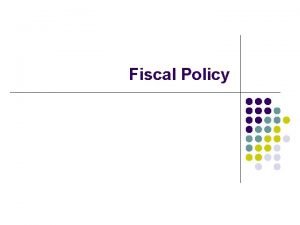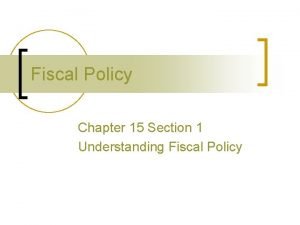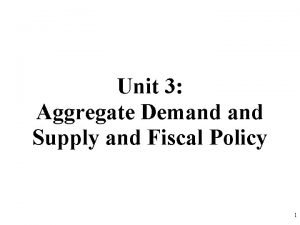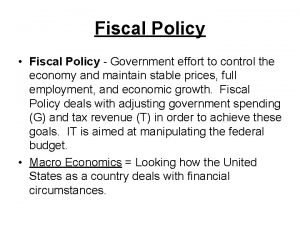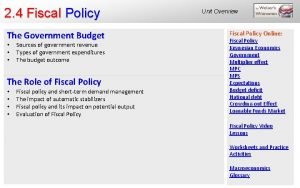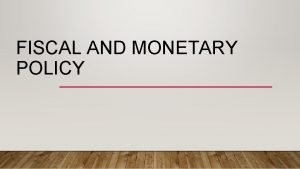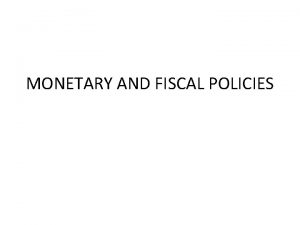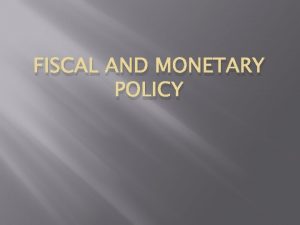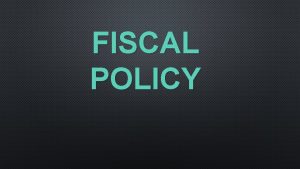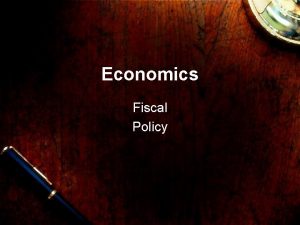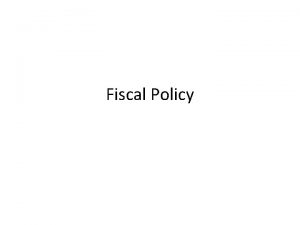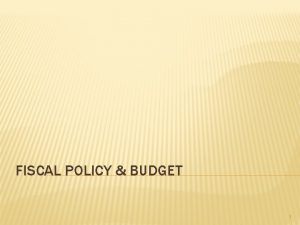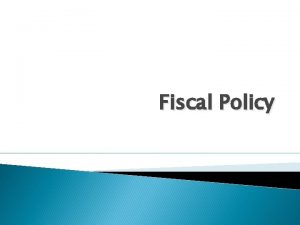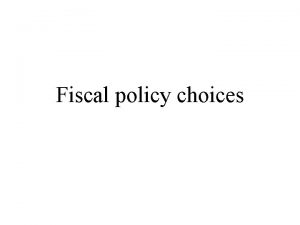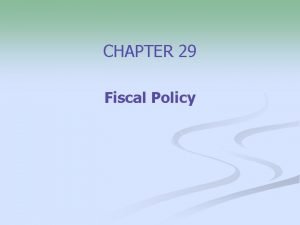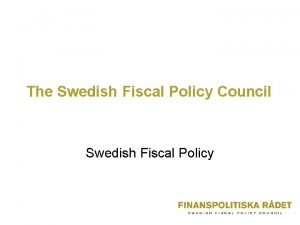FISCAL POLICY Fiscal policy is the policy concerning
















- Slides: 16

FISCAL POLICY

Fiscal policy is the policy concerning the revenue expenditure and debt of the govt. for achieving certain objectives like control of inflation, public expenditure. According to Prof. D. C. Rowan, - Fiscal policy is defined as ”the conscious attempts of govt. to achieve certain macro goals of policy by alteringthe volume and pattern of its revenue and expenditure and balance between them.

Objectives of Fiscal Policy 1. Full employment- The main aim of every govt. is to attain full employment level. In order to achieve full employment level govt. increases public expenditure to raise aggregate demand tax rate is decreased As a result private sector gets incentive to spend more when aggregate demand increases. Total production increases and as a result employment will also increase. 2. Price stability- Another objective of fiscal policy is price stability when price rise, it aims at decrease in demand aggregate expenditure and tax rate is also raised. purchasing power goes into the hands of general public and demand decreases because of excess supply, price go down because of fear of stock.

3. Reduction in Economic inequality – In a democratic country like India the pointment aim of fiscal policy is to remove economic inequality. To remove economic inequality direct taxes like income tax, property taxes are levied at higher scale because the burden of these taxes fails on rich people. The income generated from these taxes is used for the welfare of the poor massed and to raised their standard of living. 4. Economic Development- Economic development is an imp. Feature of underdeveloped countries. To achieve development of a country, fiscal policy acts as a source of capital formation because if it is increased production and employment increases

Taxation policy Government expenditure Methods of fiscal policy Deficit finanching Public debt policy

Methods of Fiscal policy 1. Taxation policy – Every govt. earns revenue through taxes. With the help of taxes demand can be affected. There are two type of taxes 1. Indirect taxes 2. Direct taxes Taxes either reduce the purchasing power of the people or create inflation in economy. every change in taxes reduces the real income. Income decreases as a result demand decreases. The effect of taxes on demand depends upon taxation multiplier. Kt= ∆V/∆T =−/1 -C KT=Taxation multiplier ∆y=change in income ∆t=change in taxation c=marginal propensity to consume if taxes increases national income increases and vice versa.

2. Govt. expenditure-Public expenditure bears an imp. Effect on aggregate demand. If govt. expenditure increases, aggregate demand increases and vice versa. Public expenditure is of two types. A) For the attainment of goods and services. It affects directly aggregate demand. Kg=∆V∕∆G KG=Public expenditure multiplier G= change in govt. expenditure B) Public expenditure for pension, education, health. It affects indirectly total demand. 3. Public Debt Policy- it also affects aggregate demand. Public debt are of two types- internal debt and external debt. The effect of public debt on demand depends on various factors. If there is no increase in private demand then debt can be used for increase in aggregate demand. 4. Deficit financing – when government lends from Central Bank to cover its deficit in its budget , this is called deficit financing simply means issuing of more currency or notes at time emergencies.

Advantages Of Fiscal Policy Ø Capital Formation- fiscal policy has played a very important role in raising the rate of capital formation in country- in private as well as public sector. A major part of budgetary resources has been invested in public sector enterprises which has resulted in increase in gross domestic capital formation raises from 10. 2 % in 1950 -51, to 22. 9 % in 19971998. ØResource Mobilization – Fiscal policy has help to mobilize resource through taxes , savings , public debt. It was 70%in 1965 -66 has increase to 90% in 200102.

Ø Incentive to Private Sector- Private sector have been encouraged under fiscal policy for investment and production. Incentives are tax concession , cash subsidized etc. ØEncourages savings- Various incentive have been given to raise the rate of savings in household and corporate sector by fixed deposits , national saving, certificate tax exemptions etc. results of such incentive increase in saving rate from 10. 4 % in 1950 -51 to 24% in 2001 -02. ØPoverty alleviation and employment generationone of the major objective of fiscal policy is to eradicate poverty and generate employment.

ØReduction in inequality of income and wealth- fiscal policy of the country has been making constant Endeavour to reduce inequality of income and wealth. Resources have been mobilized from rich class to poor by way of progressive taxes, wealth tax, corporate tax. ØExport promotion- Exports have been encouraged by way of providing subsidies, concessions, tax exemptions etc. Exports have been rise from 4. 5% in 1960 -61 to 23. 4% in 2001 -02.

Drawbacks Of Fiscal Policy 1. Lack of elasticity-In countries like India, tax system is not as it is supposed to be. Moreover in these economics because of huge tax evasion. It is difficult to earn revenue from tax. 2. Non monetized sector-Although each and every activity is now awarded in terms of money, but still a major parts of economy of UDC’s like India is non monetized. In this part of fiscal policy remains unaffected. 3. Inadequate statistics – In countries like India adequate and reliable data is not availability of reliable and accurate data, the area of fiscal policy is not judged properly. 4. Illiteracy- Most of population of India is either illiterate or not in a position to understand economic policies and its implications , that is why they are not able evaluate the imp. Of fiscal policy, they also try to evade taxes.

5. Limited Sector-Fiscal policy only affects a few sector of the economy. Most of the sectors remain untouched e. g. burden of taxes on salaried person whereas big businessman hardly pay any taxes inspite of high income levels. 6. Delay in Decision- Fiscal policy needs approval by the govt. A lot of time is required for approvals, that is why decisions are not taken at proper time. 7. Limitation Regarding Full Employment-As a result of fiscal policy in connection with full employment wage rate increases. Increase in wage rate also results in increase in prices instead of increase in production. 8. Defective Tax Structure – the countr y been relying more on indirect taxes, ultimately affecting poor's persons. Direct taxes contributed 34 percent of total tax revenue in first plan which has now come down to 27. 6 percent.

9. Inflation- As a result of public expenditure on non- development heads and deficit financing demand pull inflation has taken place. High rate of indirect taxes has resulted in cost push inflation. 10. Huge investment with negative return in public sector-Investment of 2 o 4054 crore made in public sector enterprises in 1998 and 303400 crore in 2001. Return on this investment has been very low.

Fiscal policy of india § In 1991, when the economic reforms began, we faced an exceptionally severe crisis and the central govt. fiscal deficit which had reached 8. 3% of GDP in the preceding year was seen as the root cause of the crisis. This gave a sense of urgency to the need for fiscal correction and we are able to reduce the deficit to around 6% of GDP in the very first year. § The medium term objective was to reduce fiscal deficit to Be around 3% by 1996 -97. this target was never achieved. This result has been that interest rate remained high. § Much larger Investments are also needed in health and education especially in rural areas to bring social development indicators upto respectable levels comparable with other developed countries.

§ the total fiscal improvement required to achieve these twin objectives is around 5. 5% of GDP over a three years period.

 Fiscal policy definition
Fiscal policy definition Fiscal policy
Fiscal policy What is fiscal deficit
What is fiscal deficit Goals of fiscal policy
Goals of fiscal policy Example fiscal policy
Example fiscal policy Contractionary fiscal policy
Contractionary fiscal policy Unit 3 aggregate demand aggregate supply and fiscal policy
Unit 3 aggregate demand aggregate supply and fiscal policy Fiscal policy effect on interest rates
Fiscal policy effect on interest rates Crowding out effect of fiscal policy
Crowding out effect of fiscal policy Conclusion of monetary policy
Conclusion of monetary policy Fiscal policy definition
Fiscal policy definition Unit 3 aggregate demand aggregate supply and fiscal policy
Unit 3 aggregate demand aggregate supply and fiscal policy Fiscal vs monetary policy
Fiscal vs monetary policy Tax multiplier formula
Tax multiplier formula Instruments of fiscal policy
Instruments of fiscal policy What is liquidity ratio in banking
What is liquidity ratio in banking Tax multiplier formula
Tax multiplier formula

